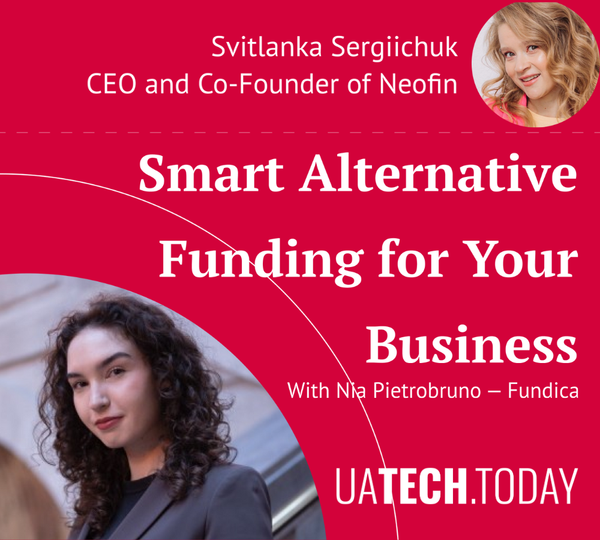Grants. Tax credits. Wage subsidies. These are just a few of the non-dilutive funding sources that thousands of startups leave on the table every year, simply because they don’t know how to access them. If you're bootstrapping or burning equity too soon, this is your wake-up call.
On April 29, 2025, UAtech hosted a high-impact webinar titled "Smart Alternative Funding for Your Business", designed to help founders unlock exactly how to find and secure capital that doesn’t cost them control of their company.
The webinar was led by Svitlanka Sergiichuk, CEO of Neofin and Editor of the Fintech section at UAtech.Today. She was joined by Nia Pietrobruno, a funding strategist at Fundica, who shared deep insights from her work connecting businesses with thousands of grant and credit programs. During the Q&A, Mike Lee, co-founder of Fundica, also joined to provide firsthand experience and advice on navigating government funding systems.
Here’s a recap of the main takeaways from the session
Why Non-Dilutive Funding Matters More Than Ever
One of the biggest takeaways from the discussion was just how widespread the struggle for funding is.
Fundica’s annual survey shows a sharp rise in concern:
56% of small businesses in 2024 reported that securing funding was their biggest operational challenge, up from 35% in 2022.
And it’s not just about finding the money. Founders face a range of frustrating roadblocks, including:
- Identifying the right programs among thousands of scattered sources
- Understanding eligibility criteria that are often vague or buried in fine print
- Completing complex, time-consuming applications, some of which exceed 30 pages
- Tracking application status or following up with funders, often with little transparency
That’s where non-dilutive funding comes in.
It offers startups a powerful way to access capital without giving up equity or control. This includes options like grants, tax credits, subsidies, and government-backed loans. Yet despite their value, these opportunities are often overlooked, either because the landscape feels too complex to navigate or simply because many founders don’t know where to start.
Understand the 5 Ws of Funding
Fundica introduced the “5 Ws” framework to help founders understand when, what, who, where, and why of alternative funding.
|
When |
Start early—some grants are open
even at idea stage |
|
What |
Explore grants, credits, loans,
guarantees before jumping to equity |
|
Who |
Government bodies, financial
institutions, incubators |
|
Where |
Use dedicated platforms like
Fundica to avoid sifting through outdated links |
|
Why |
Understand the funder’s mission
(e.g., cleantech, equity, job creation) |
Each “W” corresponds to a decision point in the funding journey. "When" refers to the timing; many founders mistakenly believe they need traction or revenue before they can qualify, but some programs are designed for very early-stage startups or even idea-stage teams. "What" helps differentiate between funding types: non-dilutive options like grants or subsidies often come with fewer strings attached than equity or private loans.
"Who" reminds founders to look beyond VCs and angels; in fact, many programs are offered by local governments, industry groups, and banks that have incentives to support startups. "Where" is all about cutting through the noise—platforms like Fundica consolidate thousands of relevant programs in one place, saving hours of painful research. And perhaps most importantly, "Why" emphasizes the need to align your application with the funder’s mission. If you're applying for a cleantech grant, make sure your impact story is front and center.
This framework helps shift the mindset from chasing capital to qualifying strategically for it—a fundamental difference that can make or break your funding journey.
Funding Isn’t One-Size-Fits-All
Different business stages call for different funding:
- Idea/Early Stage: Accelerators, hiring subsidies
- Growth Stage: R&D tax credits, export grants
- Established SMEs: Capital expenditure grants, government loans
Application Realities and Tips
- Some programs require minimal effort (like SWPP for hiring interns)
- Others (like R&D credits) can require 37+ pages and hours of work
- Reach out to funders early to confirm eligibility before you apply
- You can often "stack" grants, but you need to confirm the rules about combining funds
Key Takeaways for Founders
- Don’t default to venture capital—government and institutional grants are often better first steps
- Use tools like Fundica to navigate complexity
- Align your mission with the funder's objectives
- Evaluate the ROI of each application
- Ask for help—consultants can step in when needed
If you missed the live event, we’ve got you covered.



